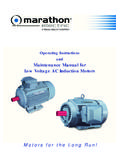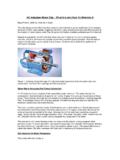Transcription of Power electronics in motor drives: Where is it? …
1 Power electronics in motor drives: Where is it?Nagarajan SridharProduct Marketing ManagerHigh Performance Isolated Power SolutionsPower ManagementTexas InstrumentsPower electronics in motor drives: Where is it? 2 June 2015 What is a motor drive ?An electric motor is a device that converts electrical energy to mechanical energy. It also can be viewed as a device that transfers energy from an electrical source to a mechanical load. The system in which the motor is located and makes it spin is called the drive , also referred to as the electric drive or motor drive .
2 The function of the motor drive is to draw electrical energy from the electrical source and supply electrical energy to the motor , such that the desired mechanical output is achieved. Typically, this is the speed of the motor , torque, and the position of the motor shaft. Figure 1 shows the block diagram of a motor drives have an undeniable presence in key systems used in our daily lives. As such, energy savings through efficiency and reliability improvement is of paramount importance and is the key focus for suppliers and regulatory standards bodies.
3 Everyday we see systems in motion all around us. What makes them move? On the outset, it may be due to wheels as in the case of an automobile. What actually drives these movements, though, are motors. Additionally, many household appliances such refrigerators, air-conditioners, ventilation fans, washers, driers and so many others all require electric motors. One can see that motors are part of our day-to-day life. The goal of this paper is to discuss the role of Power electronics the various components and requirements in motor drives through applications that we use and encounter in household and industrial 1.
4 Block diagram of a motor drive systemMotor DriveMotorElectricalSourcePowerConverter MechanicalLoadSensorControllerPower electronics in motor drives: Where is it? 3 June 2015 The functions of the Power converter circuit in the motor drive are: Transfer electrical energy from a source that could be of a given voltage , current at a certain frequency and phase as the input To an electrical output of desired voltage , current, frequency and phase to the motor such that the required mechanical output of the motor is achieved to drive the load Controller regulates energy flow through feedback coming from the sensor block Signals measured by sensors from the motor are low- Power .
5 Which are then sent to the controller Controller tells the converter what it needs to be doing. A closed-loop feedback system is the method of comparing what is actually happening to what the motor should be outputting, then adjusting the output accordingly to maintain the target outputMotor drive efficiencyElectric motors represent 45 percent of all electrical energy consumption across all applications. Increasing the efficiency of motor - drive systems could potentially result in a significant reduction in global electricity consumption [1].
6 With increasing demand of electricity along with industrialization and urbanization across the globe, the ability to supply energy is becoming even more challenging. As part of a global effort to reduce energy consumption and carbon emissions on the environment, various regulations across many countries have put forth and are continually working on governmental mandates to improve motor drive these requirements make it compelling to have an efficient Power converter system using switched-mode Power supplies (SMPS).
7 The SMPS uses semiconductor Power switches (also called Power electronic switches) in a switch mode and on and off states only, that yields 100 percent efficiency in an ideal situation. Power electronics systems are primarily designed using silicon-based Power management with Power semiconductor switches. These switches are Power MOSFETs, bipolar junction transistors (BJTs), and isolated gate bipolar transistors (IGBTs) that have made significant improvements in their performances. Examples include lower on-state resistance, increased blocking voltage , and higher drive currents.
8 Furthermore, a lot of development is taking place using wide-band-gap semiconductors such as silicon carbide (SiC). SiC is of particular interest to motor drives that transfer very high Power at high- voltage drive classificationsBefore we delve into motor drive applications and the role of Power electronics in these systems, here is a quick overview on how motor drives are classified (Figure 2).BrushedMotorsBrushlessMotorsInduction Motors PMSM*MotorsElectricalMotorsDCMotorsACMot orsFigure 2. Classification of motors *PMSM = permanent magnet synchronous motorsPower electronics in motor drives: Where is it?
9 4 June 2015 Table 1 summarizes Where AC ( induction ) and DC (brushed and brushless) motors are used in terms of voltage and Power levels, along with the pros and cons of converter in motor drivesThe drive configuration for motors summarized in Table 1 are generally the same. However, what differs is the Power converter topology in the Power converter circuit. Since the bulk of these applications are moving towards brushless DC (BLDC) or induction motors, our focus will be on applications that use these two types of general, selecting a motor drive may require looking at the Power and voltage levels while addressing questions that depend on the application.
10 Examples could be the starting torque, load inertia, pattern of operation, environmental conditions, or the motor s ability to regenerate. Addressing these questions is outside the scope of this paper. AC motor drivesThe AC motor drive , as the name suggests, requires an AC input to the induction motor used to drive large industrial loads such as HVAC for commercial buildings pumps and compressors, factory automation, industrial equipment that requires provisions for speed adjustments such as conveyor belts, tunnel boring, mining, paper mills, and many others.














